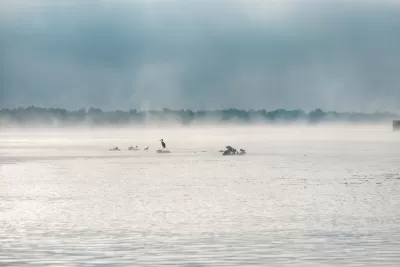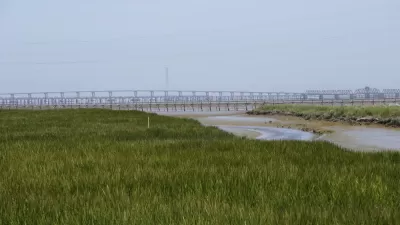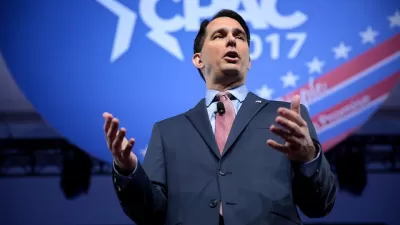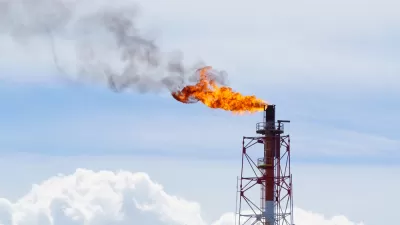President Trump's budget for 2018 has the U.S. Environmental Protection Agency take the steepest hit—31 percent. Funding for two vital programs, the Great Lakes Restoration Initiative and Chesapeake Bay Program, will have their funds eliminated.

[Updated March 21, 2017] To fund a $52 billion increase in defense spending, President Trump's budget will greatly reduce discretionary domestic spending. No agency will suffer a greater percentage drop than the U.S. Environmental Protection Agency: a loss of $2.6 billion from current levels, reports The New York Times on March 16.
The budget calls for the elimination of about 3,200 staff positions — over 20 percent of the department.
Among the other departments to see their budgets reduced:
- Health and Human Services: $12.6 billion (-16%)
- Housing and Urban Development: $4.3 billion (-12%)
- Transportation: $2.4 billion (-13%)
"The Trump administration has proposed eliminating U.S. EPA cleanup initiatives for the Chesapeake Bay and Great Lakes, but it would maintain funding for the agency's drinking water infrastructure programs," reports Ariel Wittenberg for E&E News.
"The budget returns the responsibility for funding local environmental efforts and programs to the State and local entities, allowing EPA to focus on its highest national priorities," the administration's budget request says.
Chesapeake Bay Program
"Trump's budget would slash funds for Chesapeake Bay cleanup from $73 million a year to $0," reports
Trump's budget zeroes out the $300 million EPA budget for this program, convened in 2010 under the EPA under President Obama "to accelerate efforts to protect and restore the largest system of fresh surface water in the world — the Great Lakes," according to the program's website.
The program enjoys bipartisan support. “It makes sense for us to continue to make prudent investments in protecting and improving the Great Lakes,” Gov. Scott Walker, Republican of Wisconsin, told the Associated Press. "The Great Lakes are an invaluable resource to Ohio, and The Great Lakes Restoration Initiative has been a successful public-private partnership that helps protect both our environment and our economy," stated Sen. Rob Portman, Republican of Ohio, in a press release.
Cutting the funding would have repercussions with our northern neighbor, reports Dan Levin for The New York Times, which contributes $10 million annually to the project.
The budget proposal...has dismayed the Canadian government, which cooperates with the United States to clean up and protect the Great Lakes. The lakes are the source of drinking water for 45 million people — including 10 million in Ontario, about 90 percent of its population. Ontario has the largest shoreline on the Great Lakes of any jurisdiction in Canada and the United States.
Drinking water and wastewater infrastructure
"The Trump budget does propose maintaining EPA's drinking water infrastructure programs," reports E&E's Wittenberg. "The budget requests $20 million for the Water Infrastructure Finance and Innovation Act loan program — the same amount provided by the 2017 continuing resolution."
The WIFIA program has been compared to the popular Transportation Infrastructure Finance and Innovation Act (TIFIA) Program.
Other similar programs did not fare as well.
The Department of Agriculture's water and wastewater loan and grant program would be zeroed out to save $498 million from current levels.
Cutting the aforementioned programs would be "a bloodbath budget," said Erik D. Olson, director of the health and environment programs at the Natural Resources Defense Council. "He said the cumulative effect of cutting programs like USDA's loan program, the Great Lakes initiative and enforcement would be devastating."
The president's budget is a considered a blueprint as Congress has the final word. The Associated Press explains the budget-making process in greater detail. If the president and Republican majority in Congress do not come to an agreement, a government shutdown is possible. An extension of current government spending is needed by April 29 to avoid a partial shutdown.
[Updated to correct the amount cut from the budget of the Department of Transportation.]
FULL STORY: Budget would end EPA funding for Chesapeake Bay, Great Lakes

Planetizen Federal Action Tracker
A weekly monitor of how Trump’s orders and actions are impacting planners and planning in America.

DARTSpace Platform Streamlines Dallas TOD Application Process
The Dallas transit agency hopes a shorter permitting timeline will boost transit-oriented development around rail stations.

Congressman Proposes Bill to Rename DC Metro “Trump Train”
The Make Autorail Great Again Act would withhold federal funding to the system until the Washington Metropolitan Area Transit Authority (WMATA), rebrands as the Washington Metropolitan Authority for Greater Access (WMAGA).

Supreme Court Ruling in Pipeline Case Guts Federal Environmental Law
The decision limits the scope of a federal law that mandates extensive environmental impact reviews of energy, infrastructure, and transportation projects.

Texas State Bills to Defund Dallas Transit Die
DART would have seen a 30% service cut, $230M annual losses had the bills survived.

Bikeshare for the Win: Team Pedals to London Cricket Match, Beats Rivals Stuck in Traffic
While their opponents sat in gridlock, England's national cricket team hopped Lime bikes, riding to a 3-0 victory.
Urban Design for Planners 1: Software Tools
This six-course series explores essential urban design concepts using open source software and equips planners with the tools they need to participate fully in the urban design process.
Planning for Universal Design
Learn the tools for implementing Universal Design in planning regulations.
Roanoke Valley-Alleghany Regional Commission
City of Mt Shasta
City of Camden Redevelopment Agency
City of Astoria
Transportation Research & Education Center (TREC) at Portland State University
US High Speed Rail Association
City of Camden Redevelopment Agency
Municipality of Princeton (NJ)





























